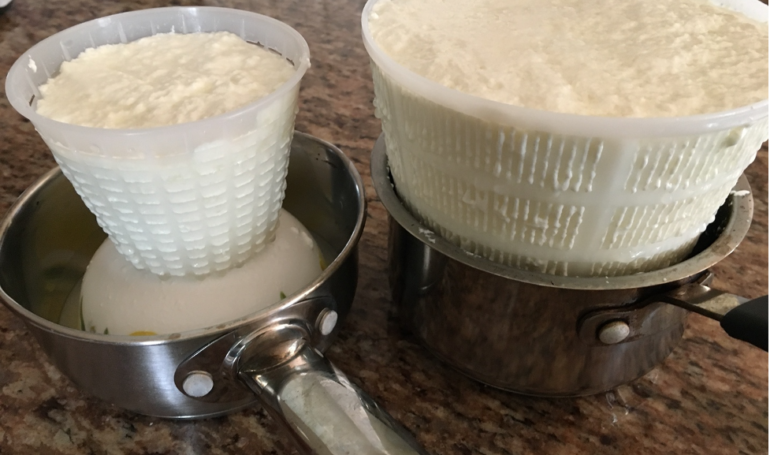
Fresh Homemade Ricotta
Used in sweet and savory dishes, or eaten straight as is, it seems homemade ricotta is everyone’s favorite cheese! I am a bit of a ricotta snob, I must confess. I grew up in Calabria, and despite my travels all over Italy, I have never found better tasting ricotta than the one I enjoy in Calabria. To say nothing compares is an understatement. When it comes to eating it as is, that is to say, not cooked, you’re going to want the fresh kind. I do occasionally buy the packaged kind, but I only use that for cooking and baking, and not to eat fresh on bread or toast. If I want to enjoy a nice bagel or panino with great ricotta, and I am not in Italy, I make my own.
The process is easy, albeit time consuming, but much of that time is spent waiting for the milk to heat up, then again to cool off at just the right temperature. Other than that, it’s relatively easy!
Many recipes you will find on the internet will call for acid of some kind, usually lemon juice or white vinegar. I myself don’t like the flavor of either in my ricotta, and despite using the least amount possible to curdle the milk, you can always taste the lemon or white vinegar. Use instead rennet, which will give you not only a perfect ricotta in consistency, but also in flavor. Be sure to use vegetable if you want to make ricotta that is vegetarian. You can also use animal rennet.
In addition to the ingredients listed below, you will need a few pieces of special equipment: a kitchen thermometer is a must. Also needed are draining baskets, and a skimmer.
Making homemade ricotta cookies? This is the perfect ricotta for them! Grab the recipe here.
Fresh Homemade Ricotta
Yield: About 1.5 to 2 lbs of fresh ricotta
Ingredients
1 gallon fresh whole milk
3/4 cup heavy cream
2 teaspoons kosher or sea salt
1 teaspoon liquid vegetable or animal rennet
Instructions
- Add the milk and cream in a heavy-bottomed sauce pan and stir to combine. Heat should be on medium – high. Warm the mixture until the temperature reaches somewhere between 200ºF to 210°F. This will take about 10 minutes.
- Transfer the milk into another pot. (It helps to speed up the cooling process if the other pot has been sitting in an ice bath.) Add the salt and stir.
- Cool the milk to about 100°F to 105°F, this will take about 1 hour or more. You can speed this up by placing the pot in a bath of ice water. (see note above.)
- In a small bowl, mix the rennet with ¼ cup cold water. Add the rennet to the now cooled milk mixture, stir it in and let stand undisturbed for about 10 minutes. After 10 minutes, the milk/cream should be substantially thicker.
- With a spoon, cut a large “cross” in the milk. Stir with the wooden spoon about 10 rotations or so, to break up the coagulated milk.
- Using the skimmer, very slowly stir in one direction. The milk will begin to separate into curds and whey. Continue stirring gently with the skimmer, moving the curds toward the center. This can take up to 5 minutes or so.
- Place the draining baskets in a shallow container or a tray and fill the ricotta draining baskets with the thickened ricotta. Let the ricotta drain at room temperature until the whey stops dripping, about 2 hours. The ricotta can be used immediately or refrigerated for later use. To serve, invert the basket onto a plate. Cover, and refrigerate any unused leftover ricotta. (I use mine up within a few days for best taste and freshness.)
*Recipe adapted from Rosetta Constantino, “My Calabria”
Leave a Reply

What to Pack for Italy
Cosa Mettere in Valigia per l'Italia
Everyone is always asking me what they should pack for Italy,
so I’ve created a quick reference guide that you can use for your next trip.
Hint: You don’t need nearly as much as you think you do!

One Comment
Awesome im going to try it
as soon as i get the thermometer ,rennet